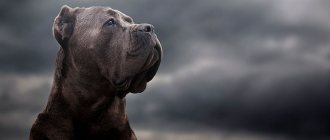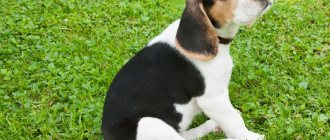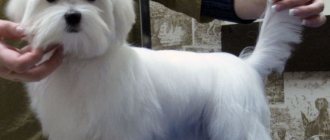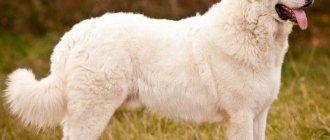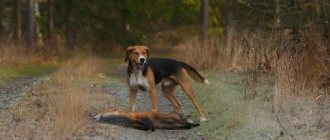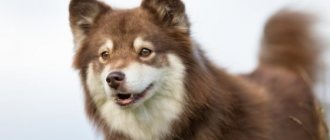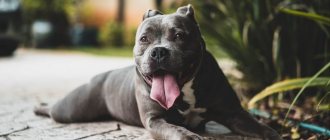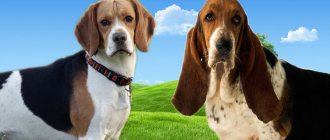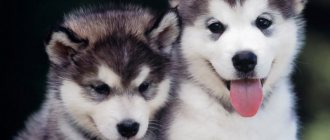History of the breed
There is no reliable information about the origin of the breed. Some call the Roman Empire the ancestral home, others call Eastern Europe. There are versions that the breed comes from the ancient wire-haired Italian Segugio. The Spinone also has characteristics of Pointers, which come from the same places as the Spinone. There are known references in the literature to a wire-haired dog imported to France from Italy or Piedmont, the presumed ancestor of the modern Spinone and the French Griffon. In the Middle Ages, such a dog was often depicted in paintings and frescoes.
It is believed that the Spinone received its modern name in the 19th century due to its thick coat: it was one of the few dogs that could hunt small game hidden in the thorny thickets (lat. prunus spinosa). These dogs have an exceptional sense of smell, but are not very fast, and although they are fast enough to successfully catch small animals, the Spinone is considered one of the slowest hunting dogs.
When faster breeds such as spaniels and setters became available, Italian hunters preferred them to the slower spinone. This, as well as the Second World War and post-war devastation, led to the fact that by the middle of the 20th century the spinones practically disappeared. The preservation and revival of the breed is due to the efforts of Dr. A. Cresoli, author of the book “Italian Spinone”. The breed standard was approved by the FCI in 1955.
Appearance
Body type
The height at the withers for males is approximately 23~27 inches; bitches are about 22~25 inches. Weight is proportional to size and constitution. Square format case. The length of the body, measured from the chest to the hip, is approximately equal to the height at the withers, with a tolerance of 1 inch allowed. Constitution: powerful, energetic dog with strong bones.
Wool
The coat is the main breed characteristic of the Spinone. Its length is about 1.5~2.5 inches. A deviation of 0.5 inches in one direction or another is allowed. Shorter on the head, on the ears, on the muzzle, on the front parts of the limbs and on the paws. On the rear parts of the legs the hair resembles a brush, but is not so long as to resemble a fringe. Long and coarse hair frames the brow ridges and lips, forming thick eyebrows, mustaches and beards and protecting it from the thorny branches of the bush. The hair is hard. The coat is hard, dense and fairly close-fitting, without undercoat.
Color
Recognizable colors include: pure white, white with orange (orange) markings, white with orange markings, white with brown (chestnut) markings, roan, brown roan. The best shade of brown is the color of a monk's dress. Colors not allowed: tricolor, tan, black in any combination.
Description
The breed is similar to other wirehaired gundogs, such as the German Pointer, but is significantly more robust. This is a large and solid dog. The standards require that males reach 60-70 cm at the withers and weigh 32-37 kg, and females 58-65 cm and weigh 28-30 kg.
This is a large breed with strong bones and is more of a leisurely walker than a fast runner. The dog is well built, square type.
The muzzle is very deep and wide, and appears almost square. She looks even larger than she really is thanks to her coarse fur. The eyes are widely spaced and almost round. The color should be buff, but the shade is determined by the dog's coat. This breed has long, drooping, triangular-shaped ears.
The coat is the most defining characteristic of the breed. Surprisingly, the dog has no undercoat. This dog has a coarse, thick, flat coat that is rough to the touch, although not as thick as a typical terrier. Hair is shorter on the face, head, ears, front of the legs and feet. On the face they form mustaches, eyebrows and a tufted beard.
There are several colors: pure white, white with red or chestnut markings, red or chestnut roan. Black color is unacceptable, as are tri-colored dogs.
Advantages of the breed:
- working dogs;
- pets are in good health;
- guard breed.
The Italian Spinone has a patient and affectionate nature. Interactions between the owner and the dog should develop at the level of companion friends. It is recommended to walk the dog in country parks and forests; this is the only way the dog can run around and take a walk. Active physical exercise is very important for the formation of good health of your pet. In any business, the Italian Spinone needs the company of its owner, so it is optimal to have this breed for sports and active people who are ready to walk a lot and exercise the dog. The pet wants to take part in all significant family affairs.
The Italian Spinone is an intelligent breed that understands what is asked of them. The Italian Spinone can get along with other pets. This breed has a good bond with dogs. He is wary of small animals. It is recommended not to leave Italian Spinone alone with squirrels, rabbits and mice. Working and hunting dogs still have the instinct to chase and catch small game.
In order not to be afraid that your pet will catch a small animal, you need to raise the dog from an early age and train it correctly, explain what can be done and what cannot be done. It is also optimal to have different animals at the same time so that they can get used to each other's existence. To prevent your pet from getting bored in your absence, you need to leave toys on the floor.
This breed should be kept in a private home and released into fresh air upon request. In general, the breed is characterized by loyalty to its owner and respects members of the household. Spinone are intelligent, patient, affectionate and playful animals.
Description of the breed
Even if we do not take into account all the advantages of this dog as a hunter, he appears to us as an interesting four-legged friend. He has a relatively easy character. This is a cheerful and cheerful dog. He is very attached to his owner and his family, ready to support any entertainment, take part in games and sports recreation. Loves jogging and long walks.
Despite his slowness, he is very active and needs physical activity. They can chase game for a long time without getting tired. This suggests that the owner of such a pet must be an active person who loves active recreation.
They can not only chase game and get it out of the thorny bushes, but also bring the shot prey into their mouths, taking it out of the pond. They are not afraid of water, even if its temperature is low enough for humans. As a pet they are very clean and obedient.
Training for them should take place in a playful way. They do not perceive aggression directed at them and often become defenseless. They themselves are not naturally endowed with aggressiveness and are completely good-natured creatures. There was not a single case known in which Spione attacked a person, much less bit him.
Their attitude towards children is reverent and patient; they will nurse a human child and try to hide from it if the pestering is too annoying. They have no inclination towards leadership and will be friendly towards other four-legged household members. Naturally, the hunting instinct can awaken in them at the sight of cats or birds. It is important to carry out timely socialization.
They don't make the best guards. They can bark, notifying the owner of the approach of a stranger, but they will not be able to attack or even defend themselves with dignity. They have good manners and are easy to care for. It is enough to periodically comb out the long, thick fur, not allowing it to get tangled or form into clumps.
Despite the lack of undercoat, they are able to tolerate cool weather, but they will not survive the harsh frosty winter outside. Their health is naturally good, and their average life expectancy is fourteen years.
Health
Like any living creature, dogs are susceptible to diseases. This breed is susceptible to diseases such as entropion of the eyelid, gastric torsion, and displacement of the hip joint. It is recommended to regularly check her hip joints as she gets older. The average life expectancy of this breed is 12-14 years. The dog has long, thick hair that doesn't feel much like wire to the touch. In order for the coat to look good, it must be constantly combed with a stiff brush. Occasionally, trimming is necessary, during which the hair in the area of the dog's body and head is manually plucked.
Vaccinations
Vaccination is carried out against the following diseases:
- canine distemper or distemper;
- parvovirus enteritis - the causative agent is parvovirus;
- infectious hepatitis - causative agent hepadnavirus;
- parainfluenza;
- rabies;
- leptospirosis;
- coronavirus;
- trichophytosis.
When should a puppy have his first vaccination?
- At 2 months the first vaccination is carried out. After the injection, the puppy should not be washed, overfed or taken outside. Immunity after the first vaccine is developed within 12 days; this period becomes the most dangerous for the baby. A person needs to make a lot of effort to alleviate the puppy’s condition. After the first vaccination, puppies experience increased body temperature, general weakness and diarrhea.
- After 3 weeks, the puppy is given a second vaccination, but with the same vaccine. As a rule, after the second vaccination the dog feels much better, but for 12 days it must be protected from other animals, from drafts and not taken out for walks. After this time, walks are allowed.
- At 6 months of age, the puppy is vaccinated against rabies and a complex vaccine against several diseases. It is forbidden to vaccinate if the dog's teeth are changing. You need to wait until all the teeth are replaced, and then vaccinate the baby.
- At one year of age, the dog is given a comprehensive vaccine.
- Further, once a year the dog should be vaccinated with the same complex vaccine.
How to vaccinate a puppy?
Only a qualified specialist should vaccinate a puppy.
Before vaccination, he must examine the dog, measure its body temperature, and only if everything is normal, give the injection. The vaccine is placed either in the scruff of the neck or in the hip of the dog. The entire list of vaccinations administered by the veterinarian must be recorded in the dog’s passport. It also indicates the date of vaccination; subsequently, the owner himself will know the expected date of the next vaccination.
Italian Spinone care and dog maintenance
This breed can be called relatively easy to care for if you know a few simple facts:
- A dog's fur sheds twice a year. During this time, she is combed daily until the old fur is completely removed.
- The rest of the time, it is enough to brush the dog weekly and remove particularly tenacious burrs after a walk. This procedure is very simple, since the dog’s hard hair does not allow plant seeds to be retained for a long time - they eventually slide off and are discarded on their own.
- Droopy ears should be inspected weekly and cleaned if necessary. The eyes are examined every day, removing dried dark discharge. If inflammation of foreign bodies appears, as well as profuse purulent discharge, you should contact a veterinarian.
- Heavy and agile, spinones usually wear down their claws on their own.
- But their teeth can become overgrown with plaque if the dog constantly eats soft food. To clean your teeth, you can use toothpaste and a brush, or special bones and sticks such as Dental, as well as dry food with large granules, cartilage and large beef bones.
Spinone is an excellent dog for a country house or cottage. The city apartment is a bit cramped for her. The exception is when the owner likes to walk a lot and takes his dog with him everywhere. To limit movement around the site, if necessary, an enclosure will be required.
Since spinones do not have an undercoat, they will need to be insulated in cold regions. But in general, these dogs behave well inside the house, rarely cause trouble for their owners and quickly learn to toilet outside. Therefore, they can be taken into the house in the evening or in cold weather.
Care
The Italian Spinone has a thick, coarse coat without undercoat. Her hairs need to be plucked several times a week to prevent them from getting stuck and causing itching. Spinone should not be washed regularly as its skin produces oil. On the one hand, it protects the dog from the cold, on the other, it creates a unique smell necessary for communication with other animals. The fur can be wiped clean of dirt with a damp towel; a full bath should be carried out once every one and a half to two months.
Droopy ears do not allow moisture to dry out quickly, so it is important to regularly clean the ears and canals. You need to brush your dog's teeth at least once a week. Nails need to be trimmed as they grow.
Hip dysplasia, which is typical for many breeds, did not bypass this dog, so it is better to closely monitor the pet’s health and undergo medical examination.
Food spinone
Given the large size and subdued colors of the breed, owners of these dogs may encounter two main problems - allergic reactions and musculoskeletal problems. Dysplasia is an abnormal formation of the acetabulum and is quite common in this breed. It should be noted that in addition to the hereditary component, this disease often develops when puppies are raised improperly, especially if they are heavy breeds. Such puppies should not be overfed, as excess weight overloads the joints and ligaments. In addition to dysplasia, fat puppies may develop a set of front, cow-like rear, or close hock joints.
Feeding young spinone should combine nutrition and the absence of extra calories. Those owners who do not have sufficient knowledge are recommended to use ready-made food for large breed dogs. They do not contain excess fat, and often add glucosamine and other drugs that help the proper formation of joints and ligaments. Puppy food must contain vitamin D, calcium and phosphorus in the correct proportions.
When using a natural diet, you need to use rice, vegetables and meat, adding special vitamin supplements to your diet daily. Feeding dogs with allergies should be organized so that foods that cause a hyperimmune reaction are absent from the diet. Identification of such products is carried out by a veterinarian. The owner's first aid kit must contain antihistamines in case a reaction occurs to any new products.
Italian Spinone training
Training the Spinone is an essential part of this dog's life. There are many directions in which an owner can develop his dog. Spinone are excellent fetchers, they have a very sensitive sense of smell, they willingly make contact with strangers, and get along well with children.
These dogs learn obedience quite quickly. Especially if you start training as soon as the puppy arrives in your home. Slowness simplifies training - puppies do not try to run far or quickly and try to follow the owner.
If you call the puppy five to ten times on each walk, reward the puppy with a treat the same number of times for looking at the owner, and sit him down five times, in two weeks this basic complex will be learned. It is important to practice recall for up to 6 months, making maximum use of the innate following reflex.
Special hunting training for spinone is carried out at specialized stations. After completing a special training course, the dog receives a work book and can then officially hunt with its owner.
Spinone mating
In principle, the female is ready to meet a male and for her first heat, but you can’t breed so early!
The ideal days for mating are considered to be from 11 to 15 from the start of estrus. It is best to breed a female by the age of 2, just like males. Under no circumstances should males be bred before two years of age. Early sexual activity will not improve the health of either the dog or the offspring.
- Before mating, animals need to be given a good walk, but should not be fed. It is better to introduce dogs on neutral territory so that they can get to know each other and run around, and then lead them to the male dog’s territory.
- Matings should always be carried out only in the territory of the dog. Actually, an act of love can also happen during dating, so don’t interfere with the process.
So, you're in male territory. Most likely, no intervention will be required, and the bitch, having played enough with the male, will allow a persistent suitor to mount.
If one of the partners for mating is small in relation to the other, then you can place a pillow under the hind legs or, if the bitch is shorter, place her belly on a bent knee. This advice is more relevant for small breeds. Just don’t try to bend the bitch’s paws so that the dog can reach her.
After ejaculation, mating occurs. The male can be on the bitch or stand with his back to her. The animals will figure it out on their own. However, if the lady tries to break free or lie down, do not allow her, hold her back a little. Also try not to scare the dogs.
It happens that after mating, mating does not occur and the male immediately loses interest in the female. Be sure to carry out a control mating after 24-48 hours.
Italian Spinone puppies
Spinone puppies are funny bumpkins, curious, but slow. They need constant and close attention from the owner, as they slowly learn to coordinate their movements and often find themselves in unpleasant situations. It is important that the yard in which the puppy grows is not dangerous for him. A threat can be posed by an unclosed cellar or a hole in the garage, into which a puppy can easily fall, or by a grated floor covering in which a paw can get stuck. A clumsy kid often gets into trouble on the street. Therefore, walks with him should be leisurely, at a pace that is comfortable for him.
Excessive duration of walks usually leads to the appearance of marks, especially if the puppy grows in winter or early spring. The basic rule is that as soon as the puppy is tired, you need to go home and do it slowly enough so that he does not become overtired.
Proper raising of heavy breed puppies involves monitoring their growth and development. There are tables of dog weight depending on its age. If such a table cannot be found, you need to ensure that the baby does not show signs of obesity. Spinone dogs are great lovers of running, but you should not disperse these dogs by forcing them to follow a bicycle. An attentive owner will always notice the puppy’s fatigue and thus be able to dose the load correctly.
Spinone develops unevenly. There are periods when the dog looks small-headed, stretched out, or high-legged. This is how heavy puppies always grow up; you shouldn’t make a tragedy out of it. Spinone females are fully formed by one to one and a half years, and males by three years.
Prices for Italian Spinone puppies
Spinone is a rare breed. There is no data on the nurseries of these dogs in our country; single specimens are shown at exhibitions. The cost of a puppy in Europe is 2000-3000 euros. Before purchasing it, it is important to decide on the purpose of the dog, since working spinones of Northern Europe will not be able to be winners of exterior shows.
In the US, the cost of a Spinone puppy ranges from $700 to $5,000. Relatively inexpensive puppies are sterilized pets, intended not for breeding, but to be companions.
What determines the price of Italian Spinone puppies?
The total cost includes the breeder's costs associated with the appearance of the puppies, up to the organization of mating until the birth of the litter. After a successful mating, the breeder takes care of the puppy for two months, providing the proper care and feeding necessary for the normal development of the babies. After birth, puppies require increased attention. From a certain point, they are switched to natural, high-quality products, and they clean up after them several times a day, investing not only physical labor, but also moral labor. At the same time, you still need to support the lactating bitch. Considering that the dog is large, the daily food intake is appropriate. Unlike small breeds, Spinone requires several times more food, which requires more money to purchase. Then comes the moment of vaccination, branding, activation, and this also requires money. In addition, the baby’s exterior is taken into account. If you want to buy an Italian Spinone with excellent exterior qualities, excellent health, and prospects for the future, you need to be prepared for the fact that such puppies cannot be cheap.
Statistically, working dogs are more expensive than companion dogs, and show dogs are more expensive than working dogs.
Gender should not be a significant factor, although some breeders emphasize this. Color and flaws determine whether a puppy belongs to a certain class. The less the baby meets the breed standard, the lower its cost.
Character
The Italian Spinone is the oldest breed of the Mediterranean, presumably descended from the wire-haired gundogs that inhabited the north of modern Italy, France and part of Spain. Many of the region's hunting breeds have long bore the common name "griffon". An image of the Italian spinone in its modern guise can be found on a 16th-century fresco in the Ducal Palace in Mantua.
Hunters valued these dogs for their courage and equanimity. Spinone could easily run through swampy areas, climb into thorny thickets of thorns and was not afraid of cold water. In addition, these dogs were flexible, very patient and hardy. Another feature of the Italian Spinone was its slowness - unlike the British breeds that were gaining popularity (setters, spaniels), they did not strive to bring game to the hunter as quickly as possible. Perhaps it was for this reason that their use in hunting was gradually abandoned. The Spinone was on the verge of extinction for a long time, but now admirers of the breed have revived it. The Italian is now popular as a companion dog not only in his homeland, but also in Scandinavia, the UK and the USA.
The Italian Spinone is unusually friendly towards other animals and people. He is always happy to have company, loves to play and be the center of attention. Spinone is completely unsuitable for those who cannot devote themselves entirely to the dog: it will not be enough for him to see his beloved owners only in the morning and evening. Living in a large family with children and elderly people would suit him best. Other pets living in the same territory with him should also be sociable.
The Italian Spinone, due to its cheerful and open character, needs timely socialization more than other hunting dogs. Otherwise, he will strive for contact with other dogs and strangers, but will not know how to behave and will begin to be afraid. He needs gentle, non-aggressive, but persistent training.
Subscribe to the newsletter and get a discount at the pet store “Lubimchik”
Thanks for subscribing!
Popular questions about the breed
HOW are they suitable for the role of a pet?
Gentle, affectionate and calm, the Spinone is an excellent dog for an active rural family that can meet his needs for exercise and attention. He loves children very much, is patient with them, playful and trustworthy - but at an early age he is too boisterous for kids.
WHAT TYPE OF HOME?
A country house with plenty of space is the ideal home for spinone. But the most important thing for him is family, and he will adapt to city life if he gets regular and plenty of exercise and can fully participate in family affairs. Not recommended for a city apartment.
WHAT type of owner?
A patient and affectionate owner who sees the dog as his constant companion, enjoys country walks and other dog activities, and is not obsessed with cleanliness in the house - for such a person the Italian Spinone is a good choice. The dog needs constant company, physical activity and mental stimulation. She wants to fully participate in her owner's life and is not suitable for those people who disappear all day at work.
HOW do they get along with other pets?
The sociable Spinone gets along well with other animals and enjoys the company of other dogs, although like all breeds, he needs early socialization. But still, this is a hunting dog with innate chasing instincts, so you should carefully introduce him to other pets.
WHAT are good qualities?
Loyal, smart, patient, affectionate, obedient, non-aggressive, open, playful.
WHAT should we be afraid of?
If a Spinona is bored, they become destructive. Without socialization they are cowardly. Definitely not for those who like strict order in the house. They howl a lot. Most of them steal food from the table and eat garbage on the street.
WHAT physical activity is needed?
Very big. An adult Italian Spinona needs at least one long walk of 60-90 minutes every day, including plenty of free time. This breed is not for passive owners! Puppies under 9 months of age should be limited to short walks and playing in the garden to prevent damage to their growing bones.
HOW easy is it to train them?
With a patient, gentle, consistent approach, this is a very intelligent breed. Well amenable to training. Spinone is very impressionable, quite obedient, and therefore does not tolerate rough treatment.
WHAT medical problems?
Generally a healthy breed, but hip dysplasia (parents should be checked) and entropy and ectropia (turning in and out) of the eyelids are occasionally encountered. Some lines carry cerebral ataxia, an inherited condition in which puppies lose control of their bodies and rarely survive beyond the age of one year.
From the story of Spinone
The breed was developed in Italy back in the 13th century. The ancestors were the wire-haired boulier-griffon hunting dogs, which can no longer be found today, French and German pointers, Cortals griffons and barbet dogs. In Italy, this breed is well known, appreciated and loved. It is little known outside the country. A distinctive feature of the breed is its slowness, due to which the dogs lost popularity as hunters, turning into companion dogs.
A muscular, large dog with strong bones and a square format, it grows to 58-70 centimeters, gaining weight from 28 to 37 kilograms. Round eyes are very expressive and kind, so the dog inspires complete trust. Their colors range from dark yellow to brown. Small, floppy ears add cuteness to the dog. The coat is longer on the neck and also forms a beard. Eyebrows and dog and eyebrows are clearly expressed. In a word, once you see Spinone’s puppy, it will be impossible to refuse and not take him. The best conditions for the dog would be a country house, where he will get a lot of physical activity, walking without a leash. Accustomed to hunting in swamps, the dog will be grateful if it has access to water.
Interesting facts about the breed
The name of the breed means thorn in Italian. It may be due to both the dog’s coat type and the fact that it works well in thorny bushes.
There are exhibition and working lines of these dogs around the world. Workers are concentrated in the Scandinavian countries. Here dogs are selected solely based on how good they are at hunting. It is unrealistic to purchase a puppy from a working kennel for a sofa.
In turn, the USA breeds the Spinone as a companion dog, paying attention exclusively to external perfection. Here this breed is assigned the role of a companion dog. Of course, show-bred dogs are very different from working dogs, both in appearance and character.
Video
Owner reviews
A few reviews:
- “We bought our Bobik in the Czech Republic. There is an official breeder with whom you can agree on purchasing a puppy online. That's what we did. When he informed us about the birth of a puppy suitable for us, we took a vacation and combined business with pleasure. Bobik is an amazing pet. He never gave us any trouble or gave us any reason to regret that we chose him rather than another, more affordable dog.”
- “We bought an Italian Pointer puppy on the Internet and only then found out the official name of the breed. It was difficult to establish life in the apartment with such a large dog. But Kerry pleasantly surprised us with her cleanliness and obedience.”

